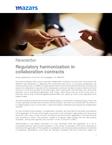
Regulatory harmonization in collaboration contracts
The great challenge when using a business collaboration contract is to know how to harmonize the different rules that govern it, especially the commercial and civil (or, in any case, substantive), tax and accounting rules. In addition to being able to find the harmonious place where they converge and coexist, the interpreter or operator of the collaboration contract must also be able to determine which rules are in force among those of the same type, which ones govern hierarchically over others and, therefore, are of preferential application and, finally, within those that are at the same level of hierarchy, which ones should be applied preferentially over others by virtue of the specialty of the subject matter.
The harmonization exercise would not be indispensable, or it would be a simpler process, if the rules of each specialty and level were coherent and concordant, but when one conflicts with the others, it is indispensable to carry out this task in order to be able to implement and execute the collaboration contract.
For the normative harmonization in collaboration contracts, we must resort to the basis and essence of the application of the law, which leads us to review in the Colombian legal system the hierarchical structure of the rules or what is known as Kelsen's pyramid and the application of the hermeneutic rule, according to which, "the provision related to a special matter prefers the one with general character", among other special rules (numeral 1 of art. 5 of law 57 of 1887).
Harmonization is not always necessary; it is only necessary when the application of a rule is inconsistent with the nature of the transaction. In this sense, for example, it will not be necessary to harmonize the application of the regulations (substantive, tax and accounting) relating to consortiums or temporary associations, since they are perfectly consistent with the current tax regime for collaboration contracts established in article 18 of the Tax Statute. In such case, the substantive, tax and accounting dynamics are naturally harmonized since the tax rule, by stating that "the parties to the collaboration contract shall independently declare the assets, liabilities, income, costs and deductions" according to their participation in those of the collaboration contract, does nothing more than reiterating the accounting dynamics established in the IFRS on joint operations.
The same does not happen, for example, with the joint venture contract which, although it is expressly considered as a business collaboration contract for the purposes of article 18 of the E.T., due to its nature and special characteristics, it is a typical joint business and not a joint operation, which makes that, when applying to it the tax rules of joint operations, all its essence is disarticulated.
The harmonization of collaboration contracts must then be done under two simultaneous methodologies; the hierarchical and the functional.
Under the hierarchical harmonization methodology, the rules applicable to the collaboration contract will be applicable from the top to the bottom of the regulatory pyramid. Thus, supranational rules related to business collaboration contracts (such as those set forth in Decision 599/2004 on VAT harmonization in business collaboration operations) will be of preferential application, followed by constitutional rules that call for the prevalence of a just order (art. 4 C.N.), followed then by the tax laws (within which is Article 18 of the Tax Statute), and followed, finally, by the opinion and doctrine of the tax authority (within which is the Unified Concept 0376/2018 on joint venture accounts).
Under the methodology of functional harmonization, the normative application of laws that are at the same hierarchical level, but that obey different matters, must be made in accordance with the hermeneutic criteria existing in the legal system.
Thus, in order to achieve functional regulatory harmonization, the special rule must be applied first over the general one (numeral 1 of art. 5 of Law 57 of 1887), and then opt for criteria for the resolution of regulatory conflicts established in the same regulations, such as that which indicates that "only for tax purposes, when there is incompatibility between the accounting and financial information rules and those of a tax nature, the latter shall prevail" (Law 1314/2009 art. 4) and that which establishes that, when there is incompatibility between the accounting and financial information rules and those of a tax nature, the latter shall prevail" (Law 1314/2009 art. 4) and that which establishes that, when there is incompatibility between the accounting and financial information rules and those of a tax nature, the latter shall prevail. 4) and the one that establishes that, except for tax regulations to the contrary, the IFRS shall be the tax basis for the determination of income tax (art. 21-1 of the E.T.).


